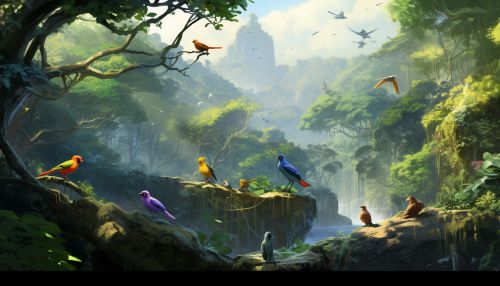The Ecology of Bird Community Dynamics and Ecosystem Services
Introduction
The ecology of bird community dynamics and ecosystem services is a complex and fascinating field of study. It involves the examination of how bird populations interact with each other and their environment, and how these interactions contribute to the provision of ecosystem services. Ecosystem services are the benefits that humans derive from ecosystems, such as food, water, climate regulation, and recreational opportunities.


Bird Community Dynamics
Bird community dynamics refer to the changes in bird populations over time and space. These changes can be influenced by various factors, including environmental conditions, availability of food, predation, and competition for resources. Understanding bird community dynamics is crucial for conservation efforts, as it can provide insights into the health and stability of ecosystems.
Species Diversity
One of the key aspects of bird community dynamics is species diversity, which refers to the variety of bird species in a given area. Species diversity can be influenced by factors such as habitat quality, availability of food resources, and climatic conditions. High species diversity is often associated with healthy and resilient ecosystems.
Population Density
Another important aspect of bird community dynamics is population density, which refers to the number of individuals of a particular bird species in a given area. Population density can be influenced by factors such as availability of food resources, predation pressure, and competition for resources. Understanding population density is crucial for managing and conserving bird populations.
Species Interactions
Species interactions, such as competition, predation, and mutualism, also play a crucial role in bird community dynamics. For example, competition for resources can influence the distribution and abundance of bird species. Predation can regulate bird populations and contribute to species diversity. Mutualistic interactions, such as those between birds and plants for pollination and seed dispersal, can enhance ecosystem function and resilience.
Ecosystem Services
Birds provide a wide range of ecosystem services, which are the benefits that humans derive from ecosystems. These services can be categorized into four main types: provisioning services, regulating services, supporting services, and cultural services.
Provisioning Services
Birds provide several provisioning services, including food and raw materials. For example, many bird species are hunted for their meat and eggs, while others are harvested for their feathers, which are used in various products such as clothing, jewelry, and crafts.
Regulating Services
Birds also provide several regulating services, which help maintain the health and stability of ecosystems. For example, birds play a crucial role in pest control by feeding on insects and rodents. They also contribute to nutrient cycling by dispersing seeds and decomposing organic matter.
Supporting Services
Supporting services are the ecosystem processes that are necessary for the production of all other ecosystem services. Birds contribute to several supporting services, including pollination, seed dispersal, and nutrient cycling. For example, many bird species help pollinate plants by transferring pollen from the male parts of a flower to the female parts. They also help disperse seeds by eating fruits and excreting the seeds in different locations.
Cultural Services
Birds provide several cultural services, which are the non-material benefits that humans derive from ecosystems. These services include recreational opportunities, aesthetic enjoyment, and spiritual enrichment. For example, birdwatching is a popular recreational activity that provides enjoyment and relaxation for many people. Birds also have cultural and spiritual significance in many societies, and they are often featured in art, literature, and folklore.
Impacts of Human Activities on Bird Community Dynamics and Ecosystem Services
Human activities can have significant impacts on bird community dynamics and ecosystem services. These impacts can be both direct, such as through habitat destruction and hunting, and indirect, such as through climate change and pollution.
Habitat Destruction
Habitat destruction is one of the main threats to bird populations. It can lead to the loss of bird species and disrupt bird community dynamics. Habitat destruction can also reduce the provision of ecosystem services, as birds play a crucial role in many ecosystem processes.
Climate Change
Climate change can also have significant impacts on bird community dynamics and ecosystem services. Changes in temperature and precipitation patterns can alter bird distributions and disrupt bird community dynamics. Climate change can also affect the provision of ecosystem services, as changes in bird populations and distributions can impact ecosystem processes.
Pollution
Pollution can also have significant impacts on bird community dynamics and ecosystem services. For example, air pollution can affect bird health and reduce bird populations. Water pollution can degrade bird habitats and disrupt bird community dynamics. Pollution can also reduce the provision of ecosystem services, as it can impact bird populations and ecosystem processes.
Conclusion
The ecology of bird community dynamics and ecosystem services is a complex and fascinating field of study. It provides valuable insights into the health and stability of ecosystems, and it highlights the crucial role that birds play in providing ecosystem services. However, human activities pose significant threats to bird populations and ecosystems, and these threats need to be addressed to ensure the continued provision of ecosystem services.
